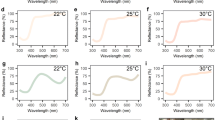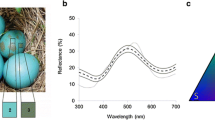Summary
Some species of North American passerines nearly always reject nonmimetic eggs placed in their nests and have apparently evolved this behavior in response to brood parasitism. Experiments presented here examined the specific egg parameters to which ‘rejecter species’ respond, the relative tolerances rejecters show towards nonmimetic eggs and the degree to which rejection is limited to eggs of the brown-headed cowbird (Molothrus ater), the only parasitic bird widespread in North America.
Relative to cowbird eggs, American robin (Turdus migratorius) eggs are larger, blue rather than white and immaculate rather than spotted. Experiments using 10 egg models at 137 nests showed that robins respond to each of these differences (Figs. 2 and 3) but do not usually reject an egg that deviates from their own by only one difference. Eggs that differ in ant two of the three parameters are usually rejected. This built-in tolerance reduces the likelihood that robins will reject their own eggs if these are atypical in size or coloration.
Small egg size was the most important parameter eliciting rapid rejections (i.e. within 1 day), probably because differnces in size can be detected by both visual and tactile perception. By contrast, small egg size was the least important parameter determining whether eggs were eventually rejected (i.e. within 5 days, Tables 2 and 3). In terms of their eventual response, robins may be more sensitive to egg coloration than to size because the latter parameter is less reliable in distinguishing between robin and cowbird eggs.
Experiments were also carried out at 37 nests of the gray catbird (Dumetella carolinensis), whose immaculate blue-green egg is only slightly larger than a cowbird egg. Catbirds are much more responsive to white ground color than to maculation (Table 4), perhaps because color is more reliable in distinguishing between catbird and cowbird eggs.
Rejecter species exhibit degrees of tolerance towards foreign eggs that are proportional to the divergence between their eggs and those of the cowbird. Birds with eggs strongly divergent from cowbird eggs benefit from being relatively tolerant because they avoid rejecting their own eggs but still act against cowbird eggs. Species with cowbird-like eggs must be relatively intolerant to maximize the chances that cowbird eggs are rejected.
Experiments show that rejection is not specific to cowbird eggs. Thus, birds have apparently responded evolutionarily to brood parasitism by developing recognition of their own eggs, rather than by developing recognition and rejection specific to parasitic eggs.
Similar content being viewed by others
References
Alvarez F, Arias De Reyna L, Segura M (1976) Experimental brood parasitism of the magpie (Pica pica). Anim Behav 24:907–916
Baerends GP (1959) The ethological analysis of incubation behaviour. Ibis 101:357–368
Beach FA (1942) Analysis of the stimuli adequate to elicit mating behavior in the sexually inexperienced rat. J Comp Psychol 33:163–207
Bent AC (1948) Life histories of North American nuthatches, wrens, thrashers and their allies. US Natl Mus Bull 195:1–475
Bent AC (1949) Life histories of North American thrushes, kinglets, and their allies. US Natl Mus Bull 196:1–452
Bent AC (1958) Life histories of North American blackbirds, orioles, tanagers, and allies. US Natl Mus Bull 211:1–549
Bower TGR (1966) Heterogeneous summation in human infants. Anim Behav 14:395–398
Curio E (1969) Funktionsweise und stammegeschichte des flugfeinderkennes einiger Darwinfinkin (Geospizinae). Z Tierpsychol 26:394–487
Finney DJ (1952) Statistical method in biological assay. Griffin, London
Friedmann H (1929) The cowbirds, a study in the biology of social parasitism. Thomas, Springfield, Illinois
Friedmann H (1963) Host relations of the parasitic cowbirds. US Natl Mus Bull 233:1–276
Friedmann H, Kiff LF, Rothstein SI (1977) A further contribution to knowledge of the host relations of the parasitic cowbirds. Smithson Contrib Zool 235:1–75
Munsell book of color, neighboring hues (1965) Munsell, Baltimore, Maryland
Poulsen H (1953) A study of incubation responses and some other behaviour patterns in birds. Vidensk Medd Dan Naturhis Foren (Khobenhavn) 115:1–131
Reed CA (1965) North American birds' eggs, revised edn. Dover, New York
Romanoff AL, Romanoff AJ (1949) The avian egg. Wiley, New York
Rothstein SI (1970) An experimental investigation of the defences of the hosts of the parasitic brown-headed cowbird (Molothrus ater). Ph D dissertation, Yale Univ, New Haven, Connecticut
Rothstein SI (1974) Mechanisms of avian egg recognition: possible learned and innate factors. Auk 91:796–807
Rothstein SI (1975a) An experimental and teleonomic investigation of avian brood parasitism. Condor 77:250–271
Rothstein SI (1975b) Evolutionary rates and host defenses against avian brood parasitism. Am Nat 109:161–176
Rothstein SI (1975c) Mechanisms of avian egg recognition: Do birds know their own eggs? Anim Behav 23:268–278
Rothstein SI (1976a) Cowbird parasitism of the cedar waxwing and its evolutionary implications. Auk 93:498–509
Rothstein SI (1976b) Experiments on defenses cedar waxwings use against cowbird parasitism. Auk 93:675–691
Rothstein SI (1977) Cowbird parasitism and egg recognition of the northern oriole. Wilson Bull 84:21–32
Rothstein SI (1978) Mechanisms of avian egg recognition: additional evidence for learned components. Anim Behav 26:671–677
Rothstein SI (1982) Successes and failures in avian egg and nestling recognition with comments on the utility of optimality reasoning. Am Zool 22:547–560
Scott DM (1977) Cowbird parasitism on the gray catbird at London, Ontario Auk 94:18–27
Seitz E (1942) Die paarbildung bei einigen cichliden. Z Tierpsychol 5:221–251
Siegel S (1956) Nonparametric statistics for the behavioral sciences. McGraw-Hill, New York
Tschanz B (1959) Zur Brutbiologie der Trottellumme (Uria aalge aalge). Behaviour 14:1–100
Yates F (1965) Sampling methods for censuses and surveys, 3rd edn. Griffin, London
Author information
Authors and Affiliations
Rights and permissions
About this article
Cite this article
Rothstein, S.I. Mechanisms of avian egg recognition: Which egg parameters elicit responses by rejecter species?. Behav Ecol Sociobiol 11, 229–239 (1982). https://doi.org/10.1007/BF00299299
Received:
Accepted:
Issue Date:
DOI: https://doi.org/10.1007/BF00299299




